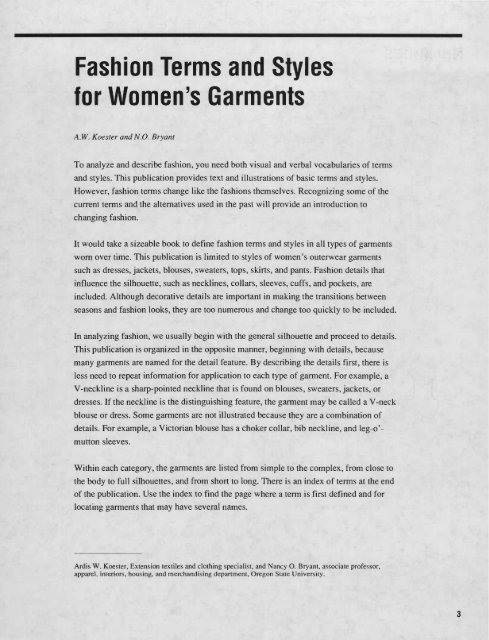Fashion Terms and Styles for Women's Garments - ScholarsArchive ...
Fashion Terms and Styles for Women's Garments - ScholarsArchive ...
Fashion Terms and Styles for Women's Garments - ScholarsArchive ...
You also want an ePaper? Increase the reach of your titles
YUMPU automatically turns print PDFs into web optimized ePapers that Google loves.
<strong>Fashion</strong> <strong>Terms</strong> <strong>and</strong> <strong>Styles</strong><br />
<strong>for</strong> <strong>Women's</strong> <strong>Garments</strong><br />
A.W. Koester <strong>and</strong> N.O. Bryant<br />
To analyze <strong>and</strong> describe fashion, you need both visual <strong>and</strong> verbal vocabularies of terms<br />
<strong>and</strong> styles. This publication provides text <strong>and</strong> illustrations of basic terms <strong>and</strong> styles.<br />
However, fashion terms change like the fashions themselves. Recognizing some of the<br />
current terms <strong>and</strong> the alternatives used in the past will provide an introduction to<br />
changing fashion.<br />
It would take a sizeable book to define fashion terms <strong>and</strong> styles in all types of garments<br />
worn over time. This publication is limited to styles of women's outerwear garments<br />
such as dresses, jackets, blouses, sweaters, tops, skirts, <strong>and</strong> pants. <strong>Fashion</strong> details that<br />
influence the silhouette, such as necklines, collars, sleeves, cuffs, <strong>and</strong> pockets, are<br />
included. Although decorative details are important in making the transitions between<br />
seasons <strong>and</strong> fashion looks, they are too numerous <strong>and</strong> change too quickly to be included.<br />
In analyzing fashion, we usually begin with the general silhouette <strong>and</strong> proceed to details.<br />
This publication is organized in the opposite manner, beginning with details, because<br />
many garments are named <strong>for</strong> the detail feature. By describing the details first, there is<br />
less need to repeat in<strong>for</strong>mation <strong>for</strong> application to each type of garment. For example, a<br />
V-neckline is a sharp-pointed neckline that is found on blouses, sweaters, jackets, or<br />
dresses. If the neckline is the distinguishing feature, the garment may be called a V-neck<br />
blouse or dress. Some garments are not illustrated because they are a combination of<br />
details. For example, a Victorian blouse has a choker collar, bib neckline, <strong>and</strong> leg-o'-<br />
mutton sleeves.<br />
Within each category, the garments are listed from simple to the complex, from close to<br />
the body to full silhouettes, <strong>and</strong> from short to long. There is an index of terms at the end<br />
of the publication. Use the index to find the page where a term is first defined <strong>and</strong> <strong>for</strong><br />
locating garments that may have several names.<br />
Ardis W. Koester, Extension textiles <strong>and</strong> clothing specialist, <strong>and</strong> Nancy O. Bryant, associate professor,<br />
apparel, interiors, housing, <strong>and</strong> merch<strong>and</strong>ising department, Oregon State University.
















